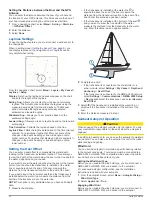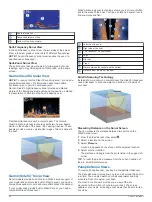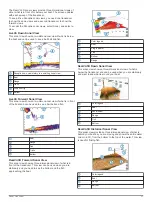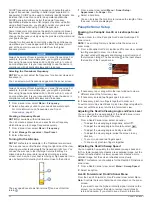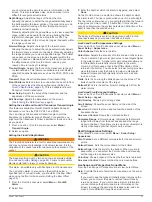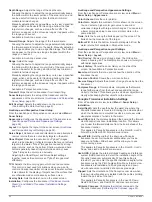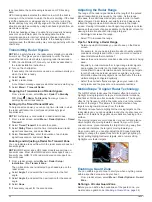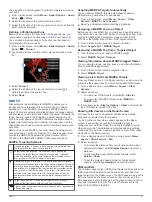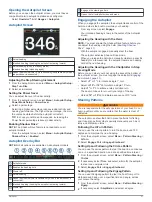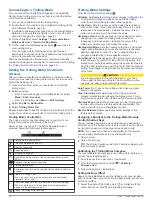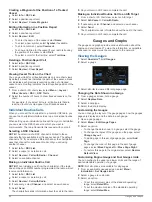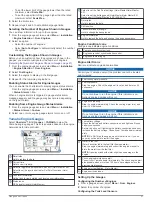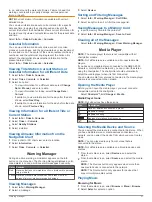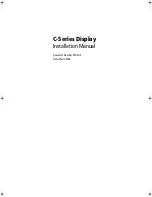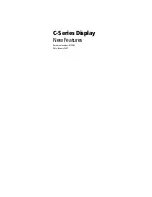
is not available, the boat heading is based on GPS tracking
data.
GPS tracking data indicates the direction in which the boat is
moving, not the direction in which the boat is pointing. If the boat
is drifting backward or sideways due to a current or wind, the
Radar overlay may not perfectly align with the chart data. This
situation should be avoided by using boat-heading data from an
electronic compass.
If the boat heading is based on data from a magnetic heading
sensor or an automatic pilot, the heading data could be
compromised due to incorrect setup, mechanical malfunction,
magnetic interference, or other factors. If the heading data is
compromised, the Radar overlay may not align perfectly with the
chart data.
Transmitting Radar Signals
NOTE:
As a safety feature, the radar enters standby mode after
it warms up. This gives you an opportunity to verify the area
around the radar is clear before beginning radar transmission.
1
With the chartplotter off, connect your radar as described in
the radar installation instructions.
2
Turn on the chartplotter.
If necessary, the radar warms up and a countdown alerts you
when the radar is ready.
3
Select
Radar
.
4
Select a radar mode.
A countdown message appears while the radar is starting up.
5
Select
Menu
>
Transmit Radar
.
Stopping the Transmission of Radar Signals
From a radar screen, select
Menu
>
Radar To Standby
.
TIP:
Press >
Radar To Standby
from any screen to
quickly stop radar transmission.
Setting Up the Timed Transmit Mode
To help conserve power, you can set up time intervals in which
the radar will transmit and not transmit (standby) signal
transmissions.
NOTE:
This feature is not available in dual radar modes.
1
From a radar screen, select
Menu
>
Radar Options
>
Timed
Transmit
.
2
Select
Timed Transmit
to enable the option.
3
Select
Stdby Time
, enter the time interval between radar
signal transmissions, and select
Done
.
4
Select
Transmit Time
, enter the duration of each radar
signal transmission, and select
Done
.
Enabling and Adjusting a Radar No Transmit Zone
You can indicate areas within which the radar scanner does not
transmit signals.
NOTE:
GMR Fantom and xHD2 radar models support two no-
transmit zones. Most other GMR radar models support one no-
transmit zone. GMR 18 HD+ radar models do not support no-
transmit zones.
1
From a radar screen, select
Menu
>
Radar Setup
>
Installation
>
No Transmit Zone
.
The no-transmit zone is indicated by a shaded area on the
radar screen.
2
Select
Angle 1
, and select the new location for the first
angle.
3
Select
Angle 2
, and select the new location for the second
angle.
4
Select
Done
.
5
If necessary, repeat for the second zone.
Adjusting the Radar Range
The range of the radar signal indicates the length of the pulsed
signal transmitted and received by the radar. As the range
increases, the radar transmits longer pulses in order to reach
distant targets. Closer targets, especially rain and waves, also
reflect the longer pulses, which can add noise to the Radar
screen. Viewing information about longer-range targets can also
decrease the amount of space available on the Radar screen for
viewing information about shorter-range targets.
• Select to decrease the range.
• Select to increase the range.
Tips for Selecting a Radar Range
• Determine what information you need to see on the Radar
screen.
For example, do you need information about nearby weather
conditions or targets and traffic, or are you more concerned
about distant weather conditions?
• Assess the environmental conditions where the radar is being
used.
Especially in inclement weather, longer-range radar signals
can increase the clutter on the Radar screen and make it
more difficult to view information about shorter-range targets.
In rain, shorter-range radar signals can enable you to view
information about nearby objects more effectively, if the rain
clutter setting is configured optimally.
• Select the shortest effective range, given your reason for
using radar and the present environmental conditions.
MotionScope
™
Doppler Radar Technology
The GMR Fantom radar uses the Doppler effect to detect and
highlight moving targets to help you avoid potential collisions,
find flocks of birds, and track weather formations. The Doppler
effect is the frequency shift in the radar echo due to the relative
motion of the target. This allows for instant detection of any
targets moving toward or away from the radar.
The MotionScope feature highlights the moving targets on the
radar display so you can navigate around other boats or severe
weather, or toward fishing spots where birds are feeding at the
surface.
The moving targets are color-coded so you can tell at a glance
which targets are moving toward or away from you. On most
color schemes, green indicates the target is moving away from
you and red indicates the target is moving toward you.
On some models, you can also adjust the M-Scope Sensitivity
setting to change the speed threshold for target highlighting. A
higher setting highlights slower targets, and a lower setting
highlights only faster targets.
Enabling a Guard Zone
You can enable a guard zone to alert you when anything comes
within a specified area around your boat.
From a radar screen, select
Menu
>
Radar Options
>
Guard
Zone
.
Defining a Circular Guard Zone
Before you can define the boundaries of the guard zone, you
must enable a guard zone (
).
36
Radar



